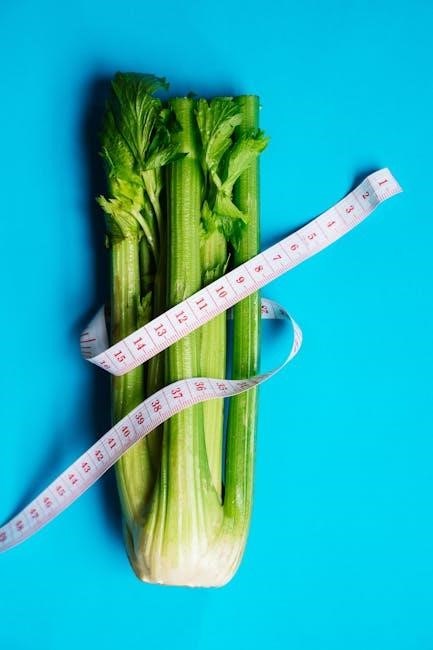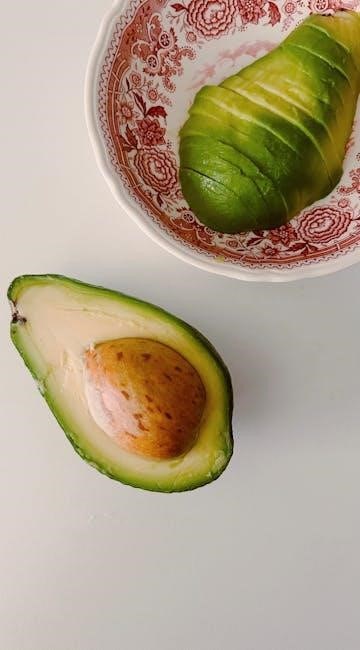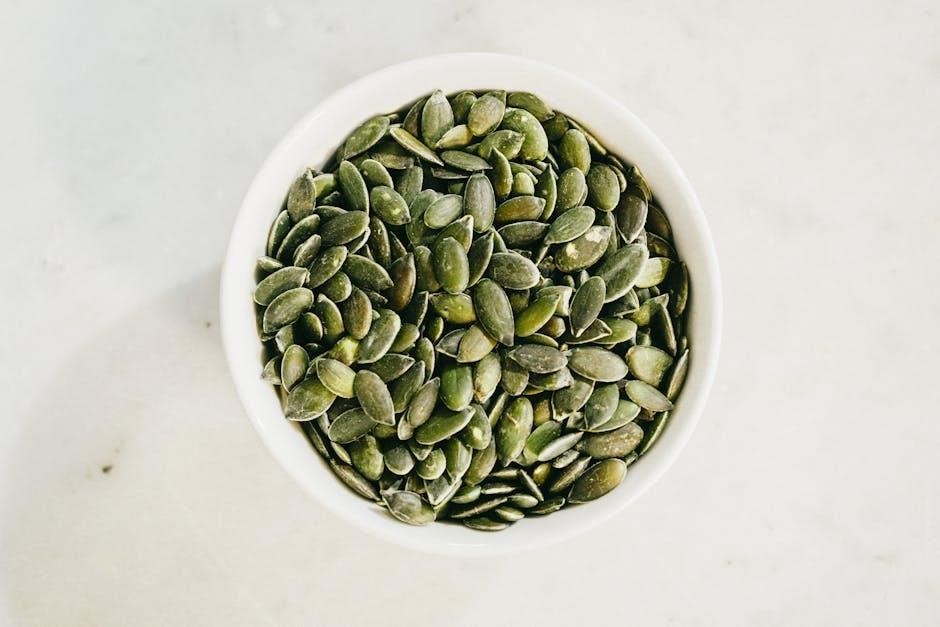A low sodium diet restricts sodium intake to 2000 mg daily, aiding heart failure management by reducing fluid retention and enhancing medication effectiveness while promoting overall heart health.
1.1 Importance of Sodium Reduction in Heart Failure
Reducing sodium intake is crucial for managing heart failure, as excess sodium leads to fluid buildup, worsening symptoms like swelling and shortness of breath. Limiting sodium helps prevent excessive fluid retention, eases the heart’s workload, and enhances the effectiveness of medications. It also supports overall cardiovascular health by controlling blood pressure and reducing strain on the heart. Adhering to a low-sodium diet is a key lifestyle modification for improving quality of life and managing heart failure effectively.
1.2 Overview of the Article
This article provides a comprehensive guide to managing heart failure through a low sodium diet. It explores the role of sodium in heart health, recommended daily intake limits, and the benefits of reducing sodium. The guide offers practical tips for transitioning to a low sodium lifestyle, including meal planning, reading food labels, and cooking advice. Additionally, it addresses fluid management, monitoring progress, and overcoming challenges. This resource is designed to help patients and caregivers understand and implement a low sodium diet effectively, emphasizing the importance of adherence and long-term commitment to improving heart health.

Understanding Heart Failure and Sodium
Heart failure occurs when the heart struggles to pump blood effectively. Sodium intake directly impacts fluid balance, with excess sodium worsening fluid retention and swelling, complicating heart function.
2.1 How Sodium Affects Heart Failure
Excess sodium increases fluid retention, leading to swelling and strain on the heart. High sodium intake can raise blood pressure, worsening heart failure symptoms. It also causes fluid buildup, making the heart work harder, which can result in fatigue and shortness of breath. Managing sodium intake is crucial to reduce these effects and alleviate heart failure complications.
2.2 Fluid Buildup and Swelling in Heart Failure
Excess sodium can lead to fluid retention, causing swelling in the legs, ankles, and feet. This fluid buildup strains the heart, worsening heart failure symptoms like shortness of breath; Reducing sodium intake helps minimize fluid accumulation, alleviating swelling and improving overall comfort for heart failure patients.

Recommended Sodium Intake for Heart Failure Patients
Heart failure patients should limit sodium intake to 2,000 mg daily, equivalent to less than one teaspoon of salt, to manage fluid retention and support medication effectiveness.
3.1 Daily Sodium Limits for Heart Failure
Heart failure patients are advised to limit daily sodium intake to 2,000 mg, equivalent to less than one teaspoon of salt. This restriction helps reduce fluid retention, alleviate swelling, and supports the effectiveness of heart medications. Adhering to this limit is crucial for managing symptoms and improving overall heart health. Patients should also avoid adding salt during cooking or at the table to stay within the recommended guidelines.
3.2 Differences in Sodium Recommendations Based on Severity
For patients with mild heart failure, sodium intake may be limited to 3,000 mg per day, while those with moderate to severe symptoms are typically restricted to 2,000 mg per day. The severity of heart failure influences these guidelines, as stricter sodium limits help manage more advanced fluid retention and symptom progression. Healthcare providers may further tailor recommendations based on individual needs, ensuring optimal management of heart failure symptoms and overall health outcomes.

Benefits of a Low Sodium Diet
A low sodium diet reduces fluid buildup, eases heart failure symptoms, and enhances medication effectiveness, improving overall heart health and well-being for patients.
4.1 Reducing Fluid Retention
Excess sodium leads to fluid retention, worsening heart failure symptoms like swelling and breathing difficulties. A low sodium diet helps reduce fluid buildup, easing these symptoms and lightening the heart’s workload. By limiting sodium, patients can minimize edema and improve overall circulation, contributing to better heart function and comfort. This makes fluid management more effective and reduces the strain on the heart, aiding in managing heart failure more efficiently.
4.2 Enhancing Medication Effectiveness
A low sodium diet enhances the effectiveness of heart failure medications by improving fluid balance and blood pressure control. Excess sodium can counteract diuretics and other medications, reducing their ability to manage symptoms. By limiting sodium, patients allow their medications to work more efficiently, leading to better symptom management and improved overall heart function. This synergy between diet and medication is crucial for optimizing treatment outcomes in heart failure patients.
4.3 Improving Overall Heart Health
A low sodium diet supports overall heart health by reducing fluid buildup and lowering blood pressure, which decreases the strain on the heart. It helps maintain healthier blood vessels and improves cardiac function. Additionally, focusing on nutrient-rich, low sodium foods like fruits, vegetables, and whole grains provides essential vitamins and minerals, such as potassium, which helps balance sodium’s effects. This holistic approach not only manages heart failure but also promotes long-term cardiovascular well-being.

Steps to Transition to a Low Sodium Diet
Gradually reduce sodium intake, avoid processed foods, and use salt-free seasonings. Monitor sodium levels in meals and adjust portion sizes to meet daily limits effectively.
5.1 Gradual Reduction of Sodium Intake
Gradually reducing sodium intake helps your taste buds adapt and minimizes cravings. Start by cutting 500 mg daily, allowing your palate to adjust over weeks. Focus on whole foods, herbs, and spices for flavor instead of salt. This approach prevents drastic changes and makes the transition sustainable. Avoid processed foods high in sodium and opt for low-sodium alternatives. Tracking intake daily ensures progress and helps maintain motivation.
5.2 Identifying and Avoiding High Sodium Foods
Identify high-sodium foods like processed meats, canned soups, and frozen meals, which often exceed 300 mg per serving. Avoid deli meats, pickled foods, and sauces. Opt for fresh vegetables, fruits, and lean proteins instead. Reading food labels helps recognize hidden sodium sources. Choose “no salt added” or “low sodium” versions of packaged foods to reduce intake effectively.
Reading Food Labels for Sodium Content
Check the nutrition label for sodium per serving, aiming for less than 2000 mg daily. Look for “low sodium” options to make informed, heart-healthy choices.
6.1 Understanding Sodium Content Per Serving
Understanding sodium content per serving is crucial for managing heart failure. Check the nutrition label to find the milligrams of sodium in each serving. Aim for foods with less than 200mg per serving to stay within the daily limit of 2000mg. Be aware of serving sizes, as they can vary. Compare labels to choose lower-sodium options, and avoid foods with over 300mg per serving to maintain a heart-healthy diet effectively.
6.2 Identifying Low Sodium Food Options
Identifying low sodium food options involves focusing on fresh, unprocessed foods like fruits, vegetables, lean meats, and whole grains. Avoid processed and canned foods, which are often high in sodium. Opt for no-salt-added or low-sodium versions of canned goods. Use herbs and spices for flavor instead of salt. When shopping, check nutrition labels for sodium content, ensuring products meet your daily limits. This approach helps maintain a heart-healthy diet while managing heart failure effectively.

Food Choices for a Low Sodium Diet
Focus on fresh, unprocessed foods like fruits, vegetables, lean proteins, and whole grains. Avoid high-sodium processed foods and opt for low-sodium alternatives to support heart health.
7.1 Fresh vs. Processed Foods
Fresh foods like fruits, vegetables, and lean meats naturally contain less sodium and more nutrients compared to processed foods. Processed foods often have high sodium levels due to added preservatives and flavor enhancers. Opting for fresh ingredients helps reduce sodium intake and supports overall heart health. When choosing processed options, select low-sodium or no-salt-added varieties to maintain a heart-healthy diet.
7.2 Low Sodium Alternatives to High Sodium Foods
Opting for fresh, unprocessed foods is ideal, but when choosing processed items, select low-sodium versions. For example, pick canned vegetables without added salt or low-sodium broths. Replace deli meats with fresh poultry or fish. Use herbs, spices, and lemon juice to season meals instead of salt. Choose whole grains and plain nuts over salty snacks. Avoid high-sodium condiments and opt for salt-free blends. These alternatives help maintain flavor while keeping sodium intake in check for heart health.
7.3 Incorporating Potassium-Rich Foods
Incorporating potassium-rich foods can help balance sodium’s effects and support heart health. Foods like bananas, spinach, sweet potatoes, and oranges are excellent sources of potassium. Potassium helps reduce sodium’s impact on blood pressure and fluid retention, which is beneficial for heart failure patients. Include these foods in moderation, as excessive potassium can also be harmful. Always consult your healthcare provider to ensure proper potassium intake aligns with your overall treatment plan.
Managing Fluid Intake with a Low Sodium Diet
Managing fluid intake is crucial alongside a low sodium diet to prevent swelling and support heart function. Limit fluids to 1.5-2 liters daily and monitor intake closely.
8.1 Importance of Fluid Management in Heart Failure
Fluid management is vital for heart failure patients, as excessive fluid can worsen swelling and strain the heart. Monitoring intake helps prevent fluid buildup and enhances medication effectiveness. Patients are often advised to limit fluids to 1.5-2 liters daily, including all beverages and foods with high water content. Tracking urine output and daily weight can help identify fluid retention early, ensuring better symptom control and overall heart health.
8.2 Tips for Monitoring and Limiting Fluid Intake
- Measure and track daily fluid intake using a cup or bottle with markings.
- Drink fluids evenly throughout the day to avoid overload.
- Avoid salty or carbonated beverages that increase thirst.
- Monitor urine color; pale yellow indicates proper hydration.
- Limit fluids before bedtime to reduce nighttime swelling.
- Use a journal or app to log intake and monitor patterns.

Cooking and Seasoning Tips for Low Sodium Meals
Replace salt with herbs, spices, and salt-free seasoning blends. Use lemon juice or vinegar for flavor. Opt for baking, grilling, or steaming to avoid added sodium.
9.1 Using Salt-Free Seasonings and Herbs
Enhance flavors with salt-free seasoning blends like herbs, spices, and lemon juice. Choose products like Mrs. Dash for added taste without sodium. Experiment with basil, oregano, garlic powder, and paprika to create delicious, heart-healthy meals. Fresh or dried herbs can elevate dishes naturally, reducing the need for salt. This approach helps manage sodium intake while keeping meals flavorful and satisfying for heart failure patients.
9.2 Alternative Cooking Methods to Reduce Sodium
Adopt cooking methods that naturally enhance flavor without added salt. Grilling, baking, steaming, and roasting are excellent choices. These techniques highlight the natural taste of ingredients, reducing the need for sodium. Try using marinades or rubs made with herbs and spices to add flavor. Avoid frying or sautéing with salted fats. These methods not only lower sodium intake but also retain essential nutrients in foods, supporting heart health and overall well-being for those managing heart failure.

Sample 7-Day Low Sodium Meal Plan
A 7-day meal plan designed for heart failure patients, focusing on balanced nutrition and low sodium intake. Includes breakfast, lunch, and dinner ideas with protein, vegetables, and whole grains to ensure variety and nutritional balance while adhering to sodium restrictions.
10.1 Breakfast Ideas
Start your day with nutrient-rich, low-sodium breakfast options. Oatmeal with fresh berries and a splash of low-fat milk is a hearty choice. Scrambled egg whites with spinach or mushrooms offer lean protein. Whole-grain toast with avocado or a small serving of peanut butter provides healthy fats. Greek yogurt with sliced bananas and a sprinkle of cinnamon is another delicious option. Smoothies made with potassium-rich fruits like cantaloupe or honeydew melon can help balance sodium levels. These meals are flavorful, nutritious, and aligned with a heart-healthy diet.
10.2 Lunch Ideas
For a satisfying and sodium-conscious lunch, try grilled chicken breast with quinoa and steamed vegetables like carrots and green beans. A hearty salad with mixed greens, cherry tomatoes, cucumber, and a light vinaigrette is another option. Consider a turkey and avocado wrap using a whole-grain tortilla and fresh veggies. Lentil soup or a stir-fry with tofu, bell peppers, and broccoli are also great choices. Pair meals with a side of fresh fruit for added nutrition and flavor.
10.3 Dinner Ideas
For a nutritious dinner, opt for baked salmon with lemon and dill, served alongside brown rice and steamed asparagus. Stir-fried shrimp with garlic, ginger, and mixed vegetables (bell peppers, snap peas) is another flavorful option. Try stuffed bell peppers with quinoa, ground turkey, and spices. Grilled chicken breast with roasted sweet potatoes and green beans is a hearty choice. Use herbs like thyme, rosemary, and basil to enhance flavor without adding salt. These meals are balanced, low in sodium, and promote heart health.
Monitoring and Adjusting Your Diet
Regularly track sodium intake and monitor weight, fluid retention, and symptoms. Adjust your diet based on progress, possibly adding potassium-rich foods or further reducing sodium if needed.
11.1 Tracking Sodium Intake
Tracking sodium intake is crucial for managing heart failure effectively. Use a food diary to record daily sodium consumption, ensuring it stays below 2,000 mg. Read food labels carefully, focusing on sodium content per serving. Utilize online tools or apps to simplify monitoring. Regularly review and adjust your diet to maintain adherence to recommendations, which helps reduce fluid retention and enhances medication effectiveness, promoting better overall heart health and well-being.
11.2 Adjusting the Diet Based on Progress
Regularly assess your progress and adjust your diet as needed to optimize heart health. Monitor symptoms like fluid retention and shortness of breath, which may indicate sodium intake adjustments. If symptoms improve, continue adhering to the low sodium plan. If challenges arise, consider further reducing sodium intake or consulting your healthcare provider for personalized guidance. Tailor food choices to meet individual needs, ensuring sustained progress and overall well-being in managing heart failure effectively.

Common Challenges and Solutions
Common challenges include sodium cravings and dining out. Solutions involve using salt-free seasonings, meal prepping, and choosing low-sodium options when eating away from home.
12.1 Managing Sodium Cravings
Managing sodium cravings can be challenging but achievable with strategic approaches. Use salt-free seasonings, herbs, and spices to add flavor without sodium. Incorporate fresh citrus or vinegar for brightness. Gradually reduce sodium intake to allow taste buds to adapt. Plan meals with potassium-rich foods, as potassium can help reduce sodium cravings. Stay hydrated and opt for naturally flavorful ingredients like garlic and ginger. Over time, your palate will adjust, making low-sodium foods more enjoyable and satisfying.
12.2 Eating Out on a Low Sodium Diet
Eating out while following a low sodium diet requires careful planning. Request modifications, such as no added salt, and choose fresh, unprocessed ingredients. Opt for grilled, baked, or steamed dishes instead of fried or sauced options. Avoid high-sodium condiments and sauces. Focus on vegetables, lean proteins, and whole grains. Don’t hesitate to ask your server for nutrition information or special requests. By making informed choices, you can enjoy dining out while staying within your sodium limits and managing heart failure effectively.
A low sodium diet is crucial for managing heart failure, reducing fluid retention, and improving medication effectiveness. Consistent adherence supports overall heart health and enhances well-being.
13.1 Summary of Key Points
A low sodium diet is essential for heart failure management, limiting intake to 2000 mg daily. Reducing sodium decreases fluid retention, enhances medication effectiveness, and promotes overall heart health. Focus on fresh, unprocessed foods, avoid high-sodium items, and use salt-free seasonings. Consistent adherence to this diet improves symptoms, supports cardiac function, and reduces complications. Monitoring and gradual adjustments are key to long-term success and better quality of life for heart failure patients.
13.2 Encouragement for Long-Term Adherence
Adhering to a low sodium diet is a powerful step toward managing heart failure and improving overall health. While it may require initial adjustments, the long-term benefits, such as reduced symptoms and enhanced well-being, make it worthwhile. Celebrate small successes, like gradually reducing your sodium intake, and remind yourself of the positive impact on your heart health. With time, this diet becomes a sustainable lifestyle change, empowering you to take control of your health and live a fuller life.

Additional Resources
- Consult heart health organizations for detailed guides on low sodium diets.
- Explore online tools for meal planning and sodium tracking.
- Review recommended reading materials on heart failure management.
14.1 Recommended Reading and Guides
For comprehensive guidance, consult the American Heart Association’s resources on low sodium diets for heart failure. Downloadable PDF guides from reputable health organizations provide detailed meal plans and sodium tracking tips. Additionally, explore heart-healthy cookbooks and online forums dedicated to managing heart failure through dietary adjustments. These resources offer practical advice and evidence-based strategies to support long-term adherence to a low sodium lifestyle.
14.2 Online Tools for Low Sodium Meal Planning
Utilize online platforms like meal planning apps and websites offering low sodium recipes. Tools such as MyNetDiary or Yummly provide customizable meal plans and sodium tracking features. The American Heart Association’s online resources also offer interactive guides and recipe databases tailored for heart failure management. These tools help create balanced, low sodium meals and track daily intake effectively, ensuring adherence to dietary recommendations and promoting overall heart health through convenient, evidence-based solutions.
